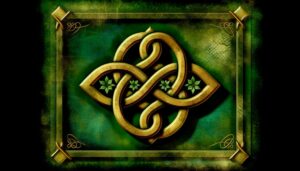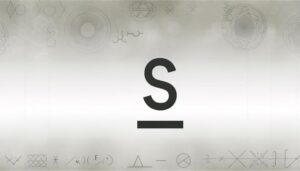What Does the Circle Triangle Symbol Represent?
The circle with a triangle symbol has roots in ancient Egypt, Greece, and Hinduism, representing balance, harmony, and interconnectedness. Alchemically, it signifies transformation and spiritual enlightenment, merging spirit with matter.
In Christianity, it denotes the Holy Trinity, while in Hinduism, it embodies cosmic forces. This symbol is frequent in art and literature, symbolizing unity and transcendence.
In modern spirituality, it underscores personal growth and mindfulness, blending ancient wisdom with contemporary practices. As an occult emblem, it points to cosmic harmony and the unity of spiritual and material domains.
Discover how this timeless symbol integrates complexity and universality.

Key Takeaways
- The circle with a triangle symbol represents balance, harmony, and interconnectedness in various ancient cultures, including Egypt, Greece, and Hinduism.
- In alchemy, the symbol signifies spiritual enlightenment, transformative processes, and the synthesis of matter and spirit.
- The symbol is associated with the Holy Trinity in Christianity and the balance of cosmic forces in Hinduism.
- Artists and writers use the symbol to convey themes of unity, balance, and the harmony between divine and earthly realms.
- Modern spirituality interprets the symbol as embodying personal growth, mindfulness, and the unity of mind, body, and spirit.
Historical Origins
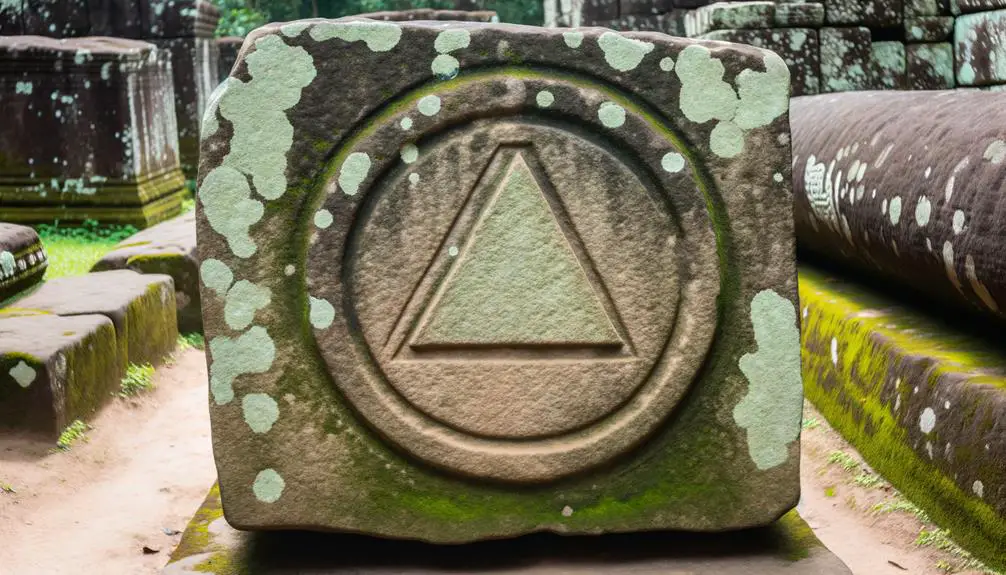
The historical origins of the circle with a triangle symbol can be traced back to ancient civilizations, where it often represented complex philosophical and spiritual concepts.
In ancient Egypt, this symbol was associated with the union of the divine and the earthly domains, signifying balance and harmony.
The Greeks later adopted and adapted the symbol, using it to explore geometric principles and metaphysical ideas. Philosophers like Pythagoras saw the triangle within the circle as a depiction of the interplay between the finite and infinite.
Similarly, in Hinduism, the symbol is linked to cosmic unity and the interconnectedness of all existence.
Such interpretations underscore the symbol's enduring significance, serving as a bridge between tangible reality and abstract thought across cultures and epochs.
Alchemical Meanings
In alchemical traditions, the circle with a triangle symbol encapsulates the transformative processes and the quest for spiritual enlightenment.
Historically, alchemy has been more than just the pursuit of material transmutation; it represents the synthesis of matter and spirit. The circle signifies wholeness, continuity, and the cyclical nature of life, while the triangle embodies the tripartite nature of existence: body, soul, and spirit.
This symbol often appeared in alchemical texts to denote the Philosopher's Stone, the ultimate goal of alchemy, symbolizing the unification of opposites and the attainment of perfection.
Consequently, the circle with a triangle serves as a visual metaphor for the alchemist's journey toward achieving personal and cosmic harmony, illustrating profound esoteric principles.
Religious Significance
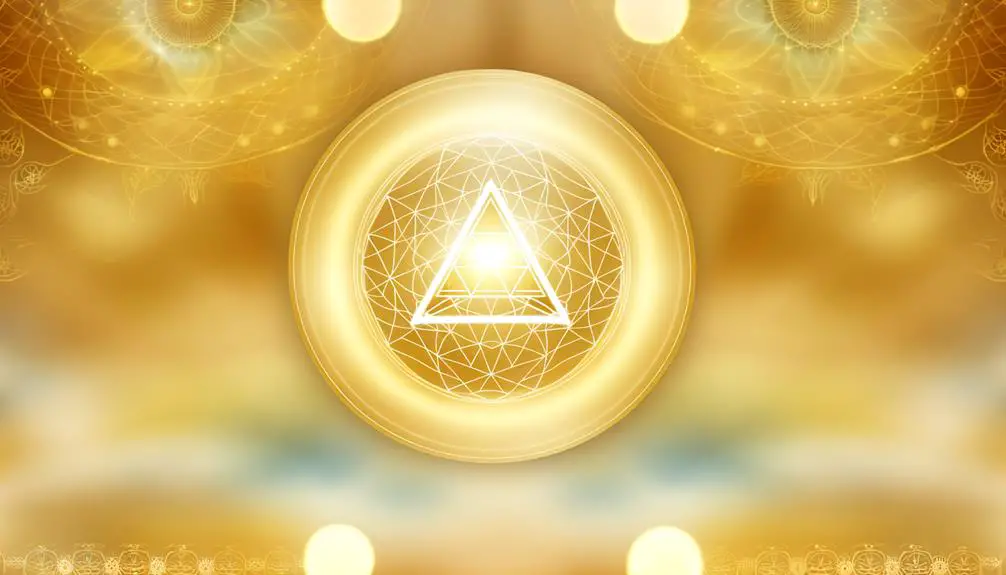
Beyond its alchemical implications, the circle with a triangle symbol also holds profound significance within various religious traditions. In Christianity, this symbol can be interpreted as the Holy Trinity (Father, Son, and Holy Spirit) encapsulated within the eternal nature of God, symbolized by the circle.
Similarly, in Hinduism, the triangle within a circle can denote the balance of the cosmic forces (Brahma, Vishnu, and Shiva) within the infinite universe. This symbol therefore serves as a visual representation of complex theological principles, emphasizing the interconnectedness of divine aspects and the wholeness of the spiritual cosmos.
Offering a rich tapestry of interpretative possibilities across different faiths, the circle with a triangle symbol represents the interplay between divine unity and the trinity. It highlights the profound connections between different aspects of divinity, providing a visual metaphor for the intricate relationships within the spiritual realm.
Cultural Variations
Throughout history, different cultures have imbued the circle with a triangle symbol with unique meanings and interpretations, reflecting their distinct philosophical outlooks and societal values.
In ancient Egypt, the symbol often represented the divine harmony of the cosmos, blending the cyclical nature of life (circle) with the hierarchical structure of society (triangle).
Similarly, in Celtic traditions, the symbol illustrated the intersection of spiritual domains and earthly existence.
In Hindu culture, it is commonly seen in yantras, symbolizing the union of male (triangle) and female (circle) energies.
Each cultural context provides a nuanced understanding of how this emblem embodies fundamental principles such as unity, balance, and the interconnectedness of the universe.
These diverse interpretations underscore the symbol's rich, multifaceted legacy.
Symbolism in Art
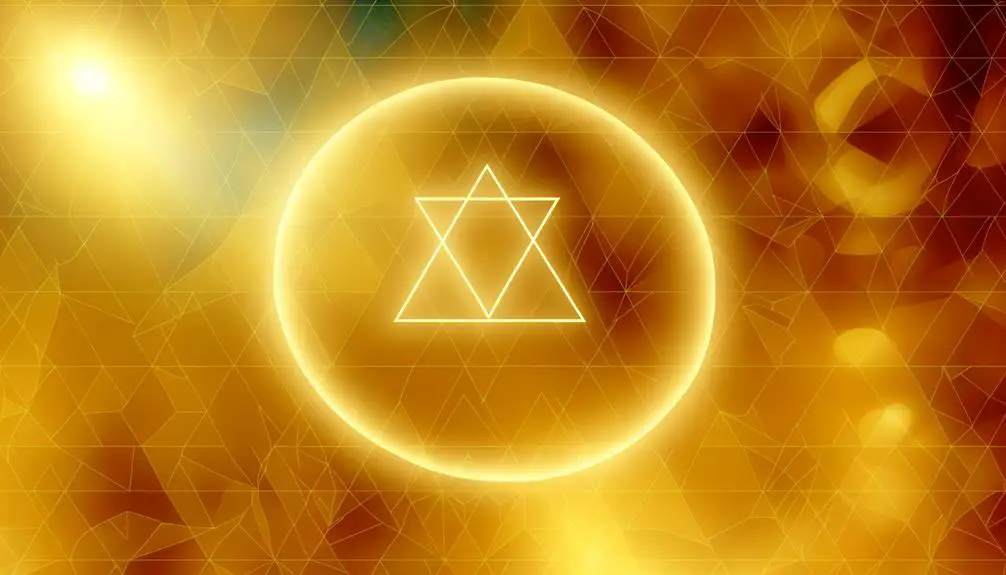
Understanding the cultural significance of the circle with a triangle symbol provides a foundational context for exploring its profound and varied expressions in the world of art.
Historically, this symbol has been utilized by artists to convey themes of unity, balance, and enlightenment. In Renaissance art, it often represented the harmony between the divine and earthly domains.
Modern interpretations frequently draw on its geometric purity to evoke a sense of equilibrium and wholeness. The symbol's enduring appeal lies in its adaptability, enabling artists to infuse their works with layers of meaning.
Whether through abstract compositions or intricate designs, the circle with a triangle continues to inspire and challenge perceptions, serving as a timeless motif in the visual lexicon of art.
Psychological Interpretations
In the domain of psychological interpretations, the circle with a triangle symbol often emerges in the context of dreams, representing a synthesis of completeness and aspiration.
Historically, Carl Jung's exploration of archetypes suggests that this symbol embodies an integration of the self, combining the wholeness of the circle with the directional force of the triangle.
This intersection of shapes serves as a powerful motif in understanding the human psyche's quest for unity and purpose.
Symbolism in Dreams
The enigmatic appearance of a circle with a triangle in dreams has been a subject of profound analysis in psychological literature, often interpreted as a symbol of unity and dynamic tension. Historically, the circle signifies wholeness and infinity, while the triangle denotes aspiration and conflict. This juxtaposition presents a rich tapestry for interpretative insight, suggesting an inner dialogue between completeness and ambition, or balance and struggle. These symbols often emerge in dreams during periods of personal transformation or existential questioning.
| Symbol | Traditional Meaning | Dream Interpretation |
|---|---|---|
| Circle | Wholeness, Infinity | Sense of completeness |
| Triangle | Aspiration, Conflict | Inner conflict, ambitions |
| Combined | Unity, Tension | Personal transformation |
This duality reflects the dreamer's subconscious mind navigating intricate emotional landscapes.
Archetypal Significance
Although the circle and triangle are often regarded as simple geometric shapes, their archetypal significance in psychological interpretations reveals deep-seated symbols that resonate within the collective unconscious, embodying themes of wholeness, aspiration, and the inherent tensions between them.
Historically, these shapes have been central in religious and philosophical iconography, conveying profound meanings:
- Circle: Represents unity, infinity, and the cyclical nature of existence.
- Triangle: Symbolizes aspiration, direction, and the triadic nature of reality (e.g., mind-body-spirit).
- Circle within a Triangle: Suggests the integration of the infinite within the finite, a reconciliation of opposites.
- Triangle within a Circle: Embodies the elevation of the finite towards the infinite.
- Union of Shapes: Reflects the psychological journey towards self-actualization and individuation.
Modern Spirituality
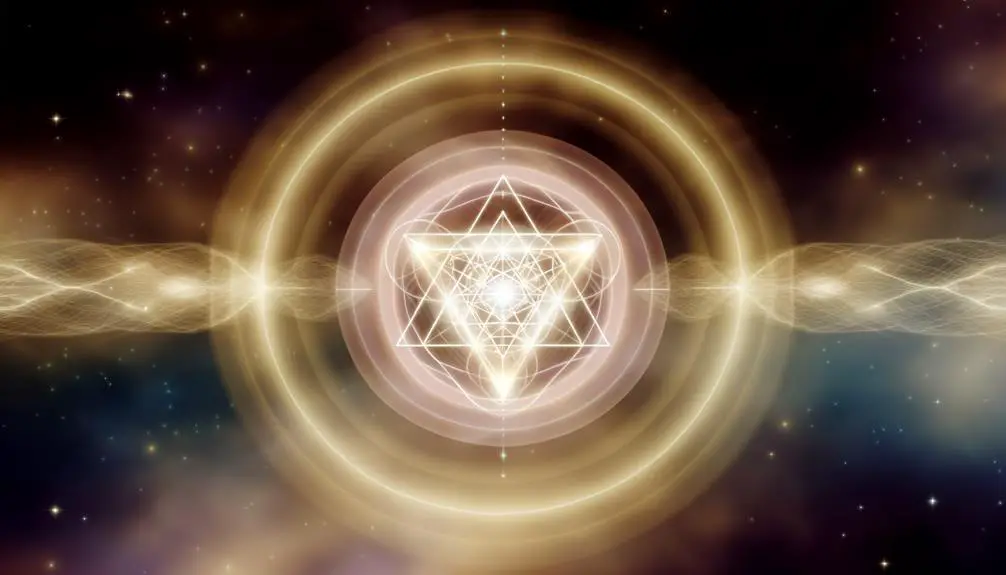
In the context of modern spirituality, the circle with a triangle symbol has undergone significant reinterpretation, reflecting evolving spiritual practices and contemporary meanings. Historically rooted in various religious and esoteric traditions, this symbol now often represents holistic unity and personal transformation within modern spiritual communities.
Its resurgence and adaptation highlight how ancient symbols are continually recontextualized to resonate with contemporary spiritual seekers, underscoring their enduring significance.
Symbolism in Modern Context
Modern spirituality often embraces the circle with a triangle symbol as a representation of the interconnectedness of mind, body, and spirit. This emblem, rooted in ancient traditions, has found new interpretations in the context of contemporary spiritual practices.
The circle signifies wholeness and infinity, while the triangle represents growth and ascension. Together, they offer a holistic view of personal development.
- Wholeness: The circle emphasizes unity and completeness.
- Balance: The triangle within the circle highlights harmony between different aspects of life.
- Transformation: It symbolizes the journey from lower to higher states of consciousness.
- Protection: Many believe it serves as a spiritual safeguard.
- Integration: This symbol underscores the fusion of diverse spiritual elements into a cohesive practice.
This synthesis of ancient and modern meanings enriches its relevance today.
Spiritual Practices Evolving
As the circle with a triangle symbol continues to embody interconnectedness and transformation, its influence on evolving spiritual practices highlights the dynamic nature of modern spirituality. Historically rooted in ancient traditions, this symbol has transcended time, finding relevance in contemporary spiritual movements.
The circle signifies unity and wholeness, while the triangle represents growth and enlightenment. Together, they resonate with the holistic approach of current spiritual practices that prioritize personal growth, mindfulness, and interconnectedness.
Modern spirituality often integrates these symbols into meditation, yoga, and healing rituals, reflecting an ongoing synthesis of ancient wisdom and contemporary understanding. This evolution underscores a collective yearning for deeper, more meaningful spiritual experiences in an increasingly complex world.
Modern Interpretations Significance
Although rooted in ancient symbolism, the circle with a triangle has gained renewed significance in modern spirituality, reflecting a profound synthesis of historical context and contemporary interpretative insight. This emblem, traditionally associated with notions of unity and balance, is now interpreted through the lens of personal growth and holistic well-being.
- Unity of Mind, Body, Spirit: Represents a balanced integration of physical, mental, and spiritual health.
- Transformation and Growth: Signifies personal evolution and self-improvement.
- Protection and Guidance: Acts as a talisman for spiritual safekeeping.
- Interconnectedness: Emphasizes the relationship between the individual and the universe.
- Sacred Geometry: Highlights the importance of geometric symbolism in understanding spiritual truths.
These interpretations underscore the timeless relevance and evolving significance of this ancient symbol in modern contexts.
Usage in Literature
The enigmatic symbol of a circle with a triangle has been used in literature to evoke themes of unity, conflict, and transcendence, often serving as a powerful motif that bridges diverse narrative traditions and cultural mythologies.
Historically, this symbol has appeared in ancient texts, representing the harmonious balance between the physical and metaphysical domains. In modern literature, it surfaces in works such as Herman Hesse's 'Siddhartha,' illustrating the protagonist's spiritual journey.
Authors use this motif to explore existential questions and the human quest for enlightenment. The juxtaposition of geometric shapes symbolizes the interconnectedness of seemingly disparate elements, offering readers a profound interpretative lens through which to understand the complexities of the human condition.
Occult and Mysticism
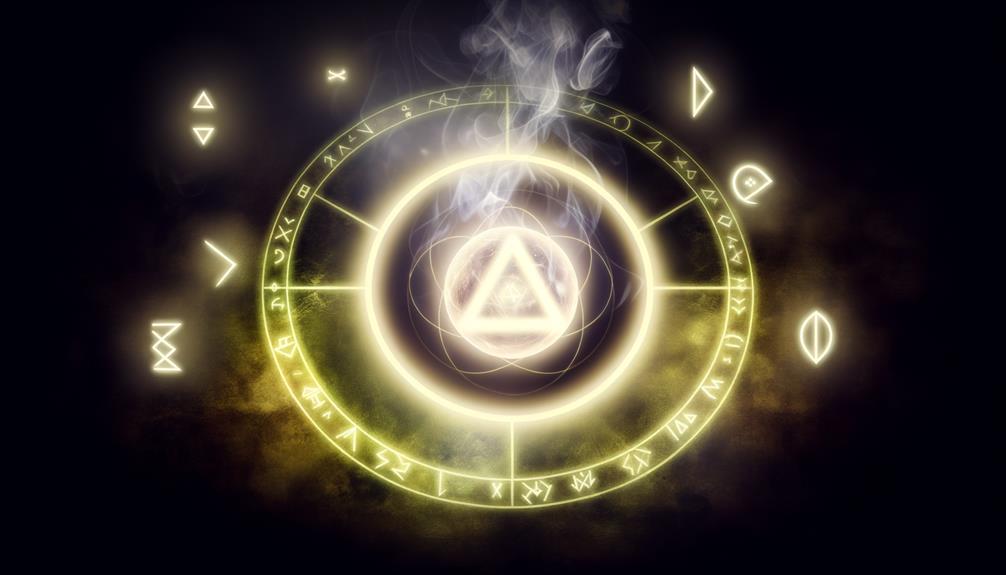
In the domain of occult and mysticism, the circle with a triangle symbol holds profound symbolic interpretations, often representing the intersection of the spiritual and material worlds. Historically, this symbol has been found in various esoteric traditions, from alchemical manuscripts to Hermetic texts, signifying unity, balance, and the integration of opposites.
Interpreted within these contexts, the symbol serves as a powerful representation of the quest for hidden knowledge and the harmonization of inner and outer realities.
Symbolic Interpretations
Within the world of occultism and mysticism, the symbol of a circle enclosing a triangle is often interpreted as a representation of the harmonious balance between the physical and spiritual dimensions. This symbolic fusion invites a myriad of interpretative insights, each conveying profound esoteric meanings.
- Unity and Wholeness: The circle symbolizes infinity and the interconnectedness of all life.
- Triadic Nature: The triangle represents the triad of mind, body, and spirit.
- Protection: Encircling the triangle, the circle acts as a safeguarding barrier.
- Alchemy: The combination signifies the alchemical union of opposites and the transformation process.
- Cosmic Order: It embodies the alignment of earthly and celestial domains, denoting cosmic harmony.
Understanding these elements enhances comprehension of the symbol's deeper implications.
Historical Significance
Throughout history, the circle with a triangle symbol has appeared in numerous esoteric traditions, each attributing distinct yet profound meanings that underscore its significance in occult and mystical practices.
In alchemy, this symbol often represents the synthesis of elemental forces, encapsulating the unity of spirit (circle) and matter (triangle).
In Hermeticism, it serves as a diagram for the interrelationship between the macrocosm and microcosm, illustrating the interconnectedness of all existence.
Within the context of Freemasonry, this emblem is seen as a representation of the Divine, where the triangle symbolizes the Holy Trinity encompassed by the infinite nature of the circle.
Such diversified interpretations reflect the symbol's deep-rooted presence in the quest for spiritual and metaphysical understanding.
Contemporary Relevance
The symbol of a circle with a triangle has gained significant traction in contemporary culture, serving as a multifaceted emblem that bridges spirituality, art, and social movements. This geometric combination is revered not only for its aesthetic appeal but also for its profound symbolic meanings.
- Spiritual Alignment: Often associated with the integration of mind, body, and spirit.
- Artistic Expression: Used by modern artists to convey themes of unity and balance.
- Social Movements: Emblematic in advocacy for equality and interconnectedness.
- Psychological Insight: Represents the triad of human experience—thoughts, emotions, and actions.
- Architectural Design: Incorporated in structures symbolizing stability and harmony.
Such interpretations underscore the symbol's enduring and evolving relevance in today's multifaceted cultural landscape.
Personal Symbolism
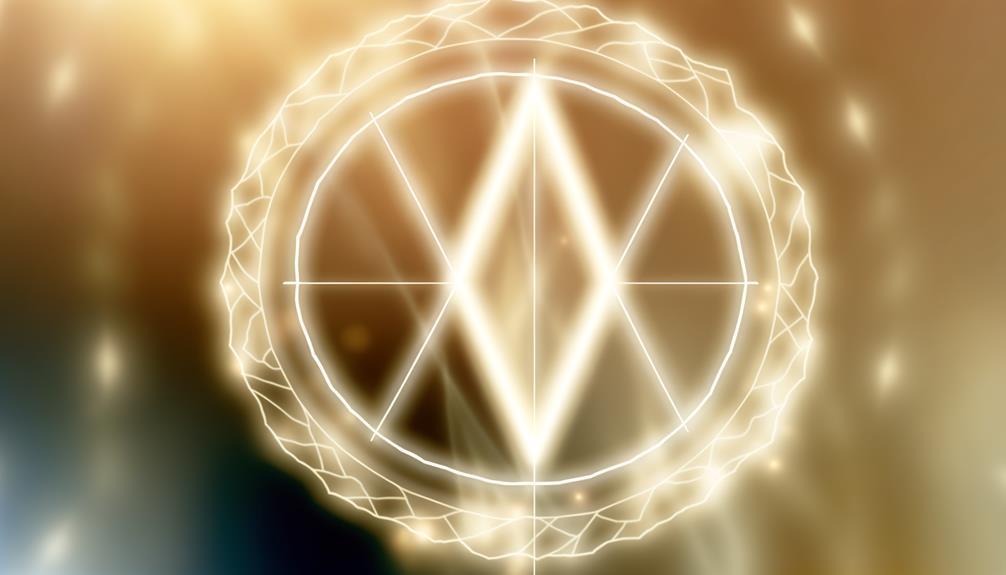
Many individuals adopt the circle with a triangle symbol as a deeply personal emblem, reflecting their unique journeys of self-discovery, transformation, and alignment.
Historically, the circle represents wholeness and unity, while the triangle signifies aspiration and growth. This synthesis of forms has been embraced in various traditions, from ancient alchemy, which viewed the triangle within a circle as a symbol of the philosopher's stone, to modern spiritual practices emphasizing balance and enlightenment.
For these individuals, the symbol becomes a talisman of their inner quest, embodying their pursuit of harmony between the spiritual and material domains. In this light, the circle with a triangle serves not just as a geometric figure, but as a profound personal narrative of continuous evolution.
Conclusion
To wrap up, the circle with a triangle symbol is a multifaceted emblem, weaving through the intricate tapestry of human history and culture like an omnipresent thread. Its historical origins and alchemical meanings resonate within religious contexts and cultural variations.
Symbolism in art and literature further enriches its enigmatic allure, while its role in occult practices and contemporary relevance underscores its enduring significance. Such a symbol, layered with interpretative depth, continues to evoke profound personal and collective insights.

